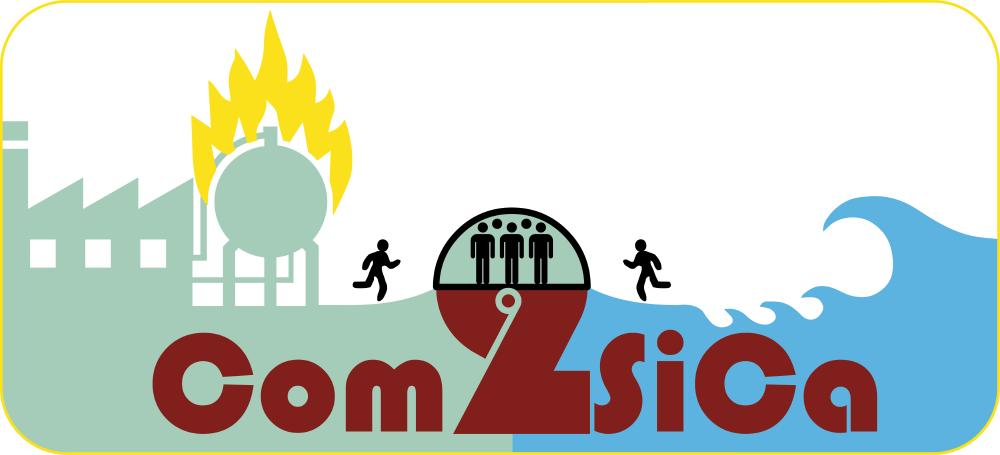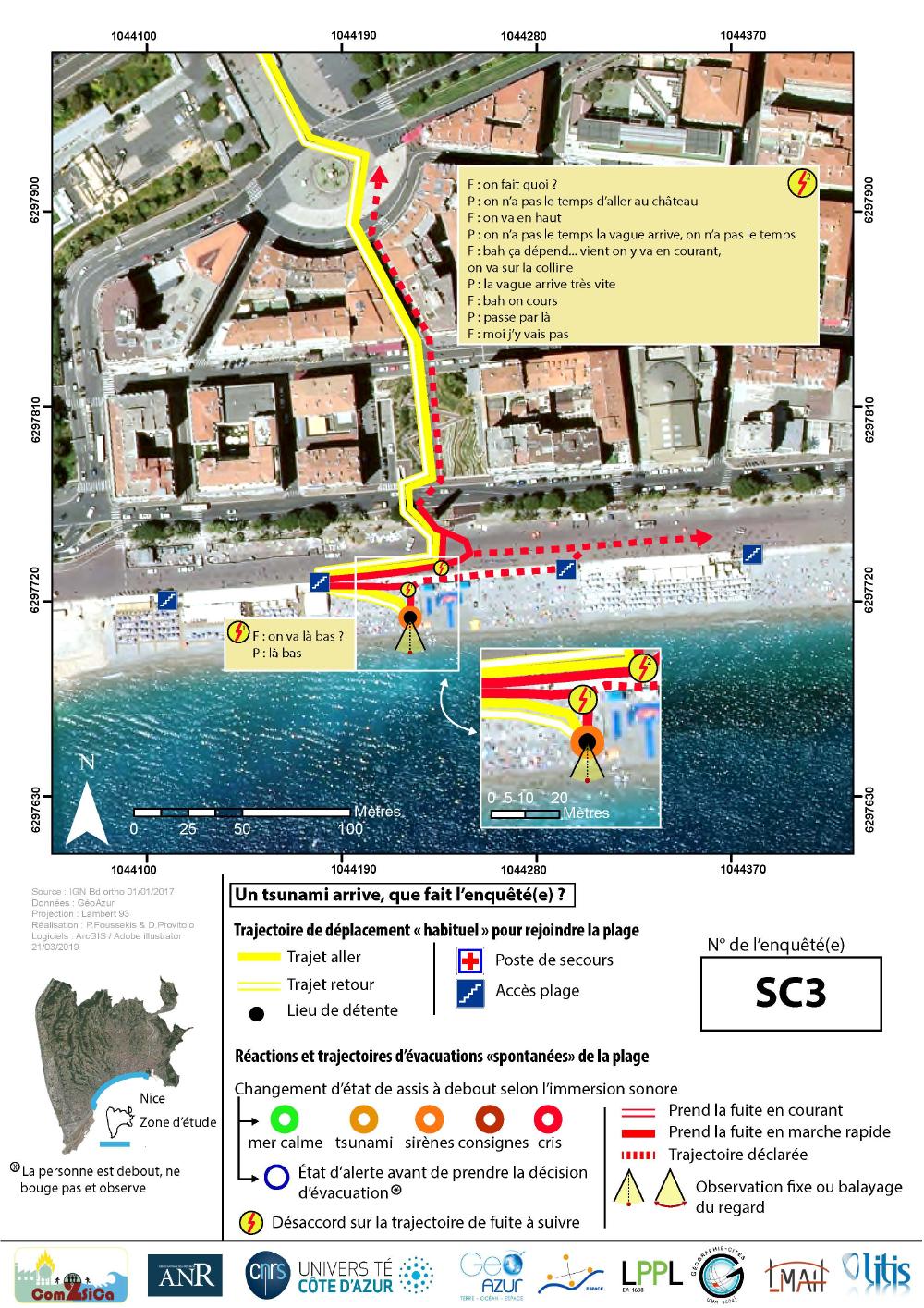Académie d'Excellence "Espace, Environnement, Risques et Résilience"
Observation and Modelling of Human Behaviours in Disaster Prone Areas
A new approach to the anticipate reactions of populations during natural or societal disaster in urban Mediterranean context

Academy 3 highlight
Com2SiCa is an interdisciplinary project involving geographers, psychologists, mathematicians, computer scientists and policy makers to study the behavioural resilience of populations during sudden and unexpected disasters. It provides key information to anticipate human behaviours in response to catastrophic hazards, a prerequisite to better protect populations.
The project
The Com2SiCa project seeks to document and understand human reactions in catastrophic situations by tackling three objectives. Our first objective was to acquire and analyze data in order to identify, describe and map human behaviours in the context of a tsunami scenario. We have developed an innovative survey protocol based on "sound immersion" to capture the population reactions to a simulated tsunami. The methods involve field studies (surveys, field observations), and data analysis is in progress. A second objective was to simulate the dynamics of human behaviours in an urban Mediterranean context. We have developed a mathematical model of the spatio-temporal dynamics of human behaviours in the face of a tsunami or terrorist attack. The first results reveal the influence of the spatial configurations on the pace of evacuation, and the influence of the "intermediate place capacity" (sites between dangerous and shelter places) on the evacuation dynamics. Finally, our third objective is to develop a graphical web interface where the modeling will be accessible to stakeholders who would need to anticipate human behaviours in the case of a catastrophic event.

The +
The Com2SiCa project addresses an important topic in a current context where growing populations are increasingly threatened by catastrophic events. Its importance is attested by the additional support it has obtained (from ANR, Direction Générale de l'Armement, label from Cluster Safe, etc.).
What’s next?
Using Com2SiCa results, stakeholders will be able to integrate knowledge on human reactions into risk management plans (this is currently not taken into account in national plans). Com2SiCa should therefore improve risk management strategies, contingency plans and public awareness.
Project information
|
Scientific domain
Geography, psychology, humanities and social sciences, mathematics, computer science, geophysics Theme
Human behaviours during disasters
|
Key words
Human behaviours
Catastrophic events
Panic
Mediterranean urban context
Surveys
Mathematical modelling
|
|
Total budget
623 k€ including : |
Students inolved
Laurie Boschetti (UCA) – PhD student
Mattia Bunel (Univ. Paris 1) - Master
Guillaume Cantin (Univ. Le Havre) – PhD student
Pavlos Foussekis (UCA) Master
Léonard Jouen (Univ. Le Havre) - Master
Denis Paton (Univ. Le Havre) - Master
|
| Partner laboratories
ESPACE, UCA
LJAD, UCA
UMR Géographie-cités, Université Paris 1, Panthéon-Sorbonne
LMAH, Université Le Havre Normandie
LITIS, Université Le Havre Normandie
LPPL, Université de Nantes
|
Project members
Moulay Aziz-Alaoui
Cyrille Bertelle
Alexandre Berred
Laurie Boschetti
Abdel Halim Boudoukha
Guillaume Cantin
Rodolphe Charrier
Edwige Dubos-Paillard
Valentina Lanza
Alexandra Lindenmann
René Lozi Oscar Navarro
Sandra Pérez
Damienne Provitolo
Emmanuel Tric
Anne Tricot
Nathalie Verdière
|
Project valorization
Publications:
- Provitolo D., Lozi R., Tric E. (2020a), Topological analysis of a weighted human behavior model coupled on a streets and places network in the context of urban terrorist attack, In : Recent Advances in Mathematical Models - optimization, industrial problems with analytic and numerical solutions ; Eds. Springer, Industrial and Applied Mathematics series.
- Provitolo D., Lozi R., Tric E., (2020b, à paraître), « A model to assess the role of spatial urban configurations on crowd evacuation dynamics during terrorist attacks », CRC Press, Taylor & Francis Group.
- Boschetti L., Provitolo D., Tric E., (2018), La modélisation conceptuelle comme aide à la construction de villes résilientes, Revue Risques urbains – Urban Risks, n° spécial : Faire la ville résiliente pour faire la ville plus sûre.
- Cantin G., Verdière N., Lanza V., 2019, Synchronization Under Control in Complex Networks for a Panic Model, International Conference on Computational Science, 2019
- Lanza V., Charrier R., Verdière N., Dubos-Paillard E., Navarro O., Provitolo D., Bertelle C., (2019), Mathematical and geographical approaches in the modeling of a network of human behavioral systems, International Conf. XTerM : compleX systems, Territorial intelligence and Mobility, June 26-28, 2019, Le Havre.
- Provitolo D. et Dubos-Paillard E., (2019), Com2SiCa - What are the dynamics of human behavior during disasters ? AAG Washington, April 3-7, 2019.
- Dubos-Paillard E., Provitolo D., Connault A., Haule S., Chalonge L., Berred A., (2019), Com2SiCa - A database to explore the human behavior at the very moment of disasters, AAG Washington, April 3-7, 2019. Provitolo D., (2019), « Présentation de la campagne d'enquêtes sur les perceptions et les comportements humains face au risque de tsunami sur le littoral azuréen (sept. 2018) » - Journée de recherche du Programme Structurant UCAJEDI Surveillance et Modélisation : application à la gestion des risques naturels nord-méditerranéens, 19 mars 2019, IMREDD, Nice.
- Provitolo D., Tricot A. (2018), Understanding and Simulation of Human Behaviors in areas affected by disasters : from analysis to anticipation, 4th World Congress on Resilience, 28-30 June, Marseille
- Provitolo D., Lozi R., Tric E. (2018), Conf. invités, From observation to mathematical modeling of human behaviour in the face of disasters: an example of transdisciplinary research, International Symposium on Computational Science and its Applications, Feb 5-6, 2018, Guru Nanak Dev University, Amritsar et Sharda University, Greater Noida, India
- Provitolo D., Verdière N. (2018), Une recherche transdisciplinaire pour comprendre les comportements humains lors de catastrophes : de l'observation à la modélisation mathématique, Séminaire pluridisciplinaire Potentiel, Trajectoire, Equilibre : approches et enrichissements pluridisciplinaires, 15 fév. 2018, Paris
- Lozi R., Provitolo D., Tric E. (2018), Conf. invités, Topological analysis of a coupled weighted panic control reflex model in the context of terrorist attack, International Symposium on Computational Science and its Applications, Feb 5-6, 2018, Guru Nanak Dev University, Amritsar et Sharda University, Greater Noida, India Provitolo D., (2018), « Les comportements humains : un levier de résilience, Journée Etude et Valorisation du Territoire, 19 fév. 2018, MSHS Sud Est.
- Cantin G., M. A. Aziz-Alaoui, Verdière N., Lanza V., Charrier R., Bertelle C., Provitolo D., Dubos-Paillard E., (2017) Control of panic behavior in a non identical network coupled with a geographical model, PHYSCON 2017, Jul 2017, FIRENZE, Italy.
- Provitolo D., Boschetti L., Castagnola F., Huet V. (2017), Le risque zéro n'existe plus ! Inondation: comment protéger ma famille (en partenariat avec la Direction Départementale des Territoires et de la Mer, le SDIS06 et le SISA), Réunion publique organisée par la Communauté d'Agglomération du Pays de Grasse, 5 décembre 2017
- Provitolo D., (2017), Conf. invitée, Resilience-based practices in the Field of Society and Nature, Symposium International RESILIO, Bucharest, Roumanie, 27-29 octobre 2017
- Provitolo D., (2017), Conf. invitée, Accroître la résilience des populations en développant la culture du risque, Conférence grand public organisée par le Secours Populaire Français, 3 octobre 2017
- Provitolo D., (séance plénière avec B. Cyrulnik, E. Philippe, S. Maire et Y. Jebrak) (2017), Conf. Invitée, La résilience au coeur des mutations des politiques publiques en général et de l’ingénierie publique en particulier, Rencontres nationales de l'ingénierie territoriale : Résilience et territoire, 1-2 juin 2017, Le Havre, France
- Provitolo D., (2017), Observer et modéliser les comportements humains lors de catastrophes : un levier pour agir sur la résilience des populations, Journée Risques sismiques et gravitaires au Liban, Institut Français, Beyrouth, Liban, 29-30 mars 2017




















